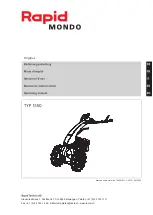
17
1.800.627.4499
PA-Series
ERV
2.0 INSTALLATION
2.1 AIRSTREAM AND FILTER ARRANGEMENTS
INSTALLATION
Read and understand this section before beginning assembly!
CAUTION
This ERV can be assembling in many different configurations. Only one of them is correct for
your job! Check your ductwork design, then determine which Assembly Arrangement to use.
1. Determine the Airflow Paths for your job.
The two airstreams are the SUPPLY (air from the outside) and the RETURN (air from the
conditioned space).
If Supply and Return enter the exchanger on OPPOSITE sides, use Arrangements 1 or 3,
Figure 2.1.0.
If Supply and Return enter the exchanger on the SAME side, use Arrangements 2 or 4, Figure
2.1.1.
If the airstreams enter the exchanger low, and leave the exchanger high (or the other way
around), this is called “cross airflow”. Use Arrangements 1 or 2.
If one airstream enters the exchanger high and leaves high and the other enters low
and leaves low, this is called “parallel airflow”. Use Arrangements 3 or 4. This airflow
configuration requires a performance derate.
2. Determine the resulting FILTER CONFIGURATION for your job.
Remember that the filters must be installed to cover the inlet faces of the core stacks.
NOTE: Deter-
mine how many
“twinned filters”
you will need to
assemble for your job.
1.5.3 Comparison of Leakage Volume and EATR Ratings
Leakage volumes presented here are application ratings for the complete PA-Series energy-
recovery unit. EATR is a certified rating point used in ARI’s 1060 program for the energy-
recovery component in the PA-Series unit. The two are related but not identical.
EATR, or Exhaust Air Transfer Ratio, is leakage through the component only, expressed as a
ratio of fresh air volume.
The driving force for leakage in the PA-Series ERV is pressure differential between the two
airstreams, which is not directly a function of airflow volume. Leakage occurs at a low rate in
the component itself, as verified by our ARI ratings, and also at about the same volume in the
case. Thus, the leakage volumes presented here are both easier to apply and more accurate
when considering the entire system.
















































